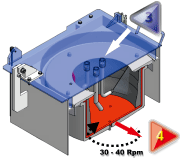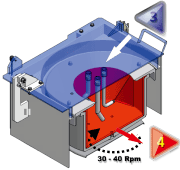E-Archive
Cover Page
in Vol. 21 - September Issue - Year 2020
Innovative Process for Automatic Cleaning of Centrifuged Muds


Step 1



Step 3



Step 4


Step 5
Rollwasch® has developed the innovative process for automatic cleaning of centrifuged muds, in its filtering systems RFC-20-A, named ARW, acronym for Automatic Roto Wash (Patent pending - I).
The family of centrifugal filters RFC-20-A designed by Rollwasch® with the innovative device ARW (Automatic Roto Wash), are automatically managed by a modern PLC combined with frequency converter, a wide set of sensors and the innovative ARW device (Patent pending - I) which simultaneously enables the automatic removal of the mud accumulated in the centrifugal basket on one hand, and on the other hand, a partial balance of the water lost during the meantime by evaporation or dropping out with each batch of finished workpieces from the mass-finishing units.
Thanks to sophisticated software, sensors, automation level and interactivity with each one of the finishing units, this advanced centrifugal filter is able to offer full compliance with the Industry 4.0 specs and, as an interesting option, the WI-FI remote management from a simple tablet PC.
Let's see first how the simple operating principle of this centrifugal filter RFC-20-A works, with automatic self-cleaning ARW, by initially observing the cross-section of the filter unit, having the following characteristics:
1. Effluents In
2. Filtered Effluents Out
3. High Pressure Water Jet Inlet
4. Mud Out
5. Rinsing Water In (1) for automatic internal cleaning
6. Rinsing Water In (2) for automatic internal cleaning
Rollwasch® summarizes with these machines, a simple solution, based on a high-pressure pump, as an alternative to mechanical devices with higher maintenance costs and investment.
STEP 1 [Start]
A) the raising pump of the receiving tank is stopped, in order to allow the correct start of the basket without unbalancing actions due to the liquid;
B) The frequency control device starts the main rotation motor of the basket, following a suitable acceleration ramp. The basket gradually reaches the fully rotation of about 3.000 RPM
C) The above-mentioned raising pump starts feeding the wastewater through the respective inlet pipe [1].
Rollwasch® has dedicated months of research and development for this project, aiming at high performance at low operative costs.
For a variable time, usually between a minimum of 1 and a maximum of 4 hours, the wastewater continues being fed, filtered from the suspended solids through centrifugation. The clarified water to be sent to the machines gets out under pressure from the pick-up pipe [2]. In the FOP version, the clarified water is conveyed into the 1m3 tank from which it is pumped to the machines; in the basic version, the clarified water must be connected directly to the machines. During the centrifugation time on the basket wall, the suspended solids are thickened, causing a thickened mud coat.
Note: the cycle time is calculated to reach a mud weight between 8 and 12kg inside the basket, depending on the density of the suspended solids.
STEP 3 [Braking to slow down the basket speed]
A) The raising pump of the receiving tank stops, in order to allow the braking of the basket without overloading it with liquid – in fact without centrifugation (without the right rotation speed) the water does not flow out anymore from the pick-up pipe of filtered liquid.
B) The frequency converter device slows down the basket rotation main motor, following a suitable deceleration ramp. The basket gradually reaches a rotation of 30-40 RPM in an area included between these two values, and the frequency converter causes a dynamic that does not centrifuge the liquid mass against the walls.
C) Once the rotation has been optimized, the liquid that till this moment was in centrifugation (about 7lt volume), descends to the centre of the basket where suitable evacuation holes have been made.
D) In parallel, when the optimal rpm has been reached, the high-pressure net water jet starts through a special nozzle and sprinkles a basket section suitable for the removal of the major volume of the mud collected until this moment.
STEP 4 [ARW mud evacuation phase]
A) The high-pressure pump, connected to the pipe [3], carries out a phase of powerful mud removal from the basket walls.
The mud flows down slowly towards the centre of the basket where the liquid muds gets out by gravity through special passing holes [4].
B) The mud removal phase can also be split into two times, in which the basket is rotating in two directions for a complete exposure of the surfaces jet.
The Rollwasch® solutions for centrifugal filtration enable, in most cases, to contain the costs related to the consumption of the chemical compound, which is recycled and restored only partially.
STEP 5 [Cleaning flush]
A) At the end of the high-pressure phase, there are still some mud traces, which are suitably twice-rinsed through introduction of water ; at first, for a few seconds, the upper side of the basket is rinsed [5].
B) Immediately afterwards, the lower area [6] is rinsed, as this makes the mud overflow easier from the suitable expulsion pipe [4] towards the outside of the filter unit;
For Information:
Rollwasch® Italiana S.p.a.
Via San Carlo, 21, 20847 Albiate (MB), Italia
Tel. +39.0362.930334
Fax +39.0362.931440
E-mail: info@rollwasch.it
www.rollwasch.it



























